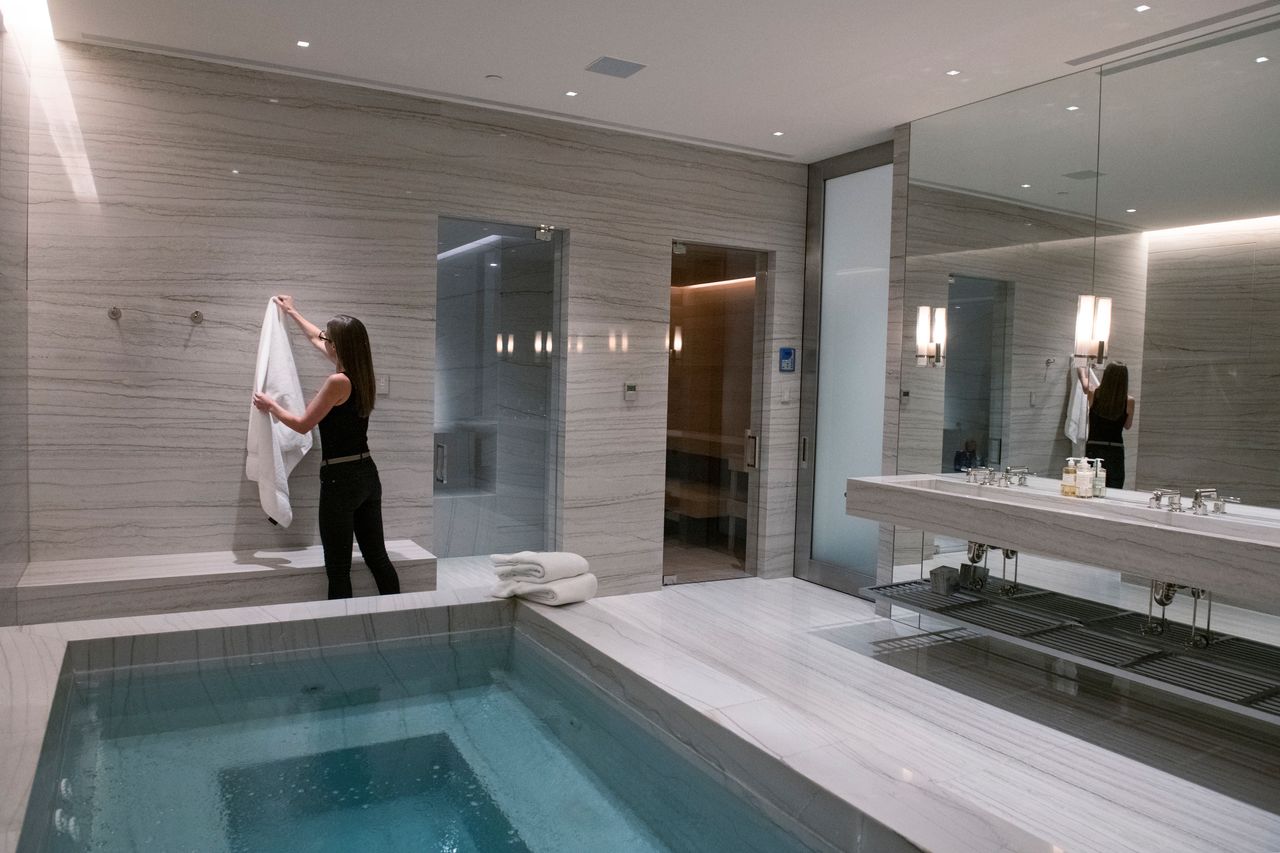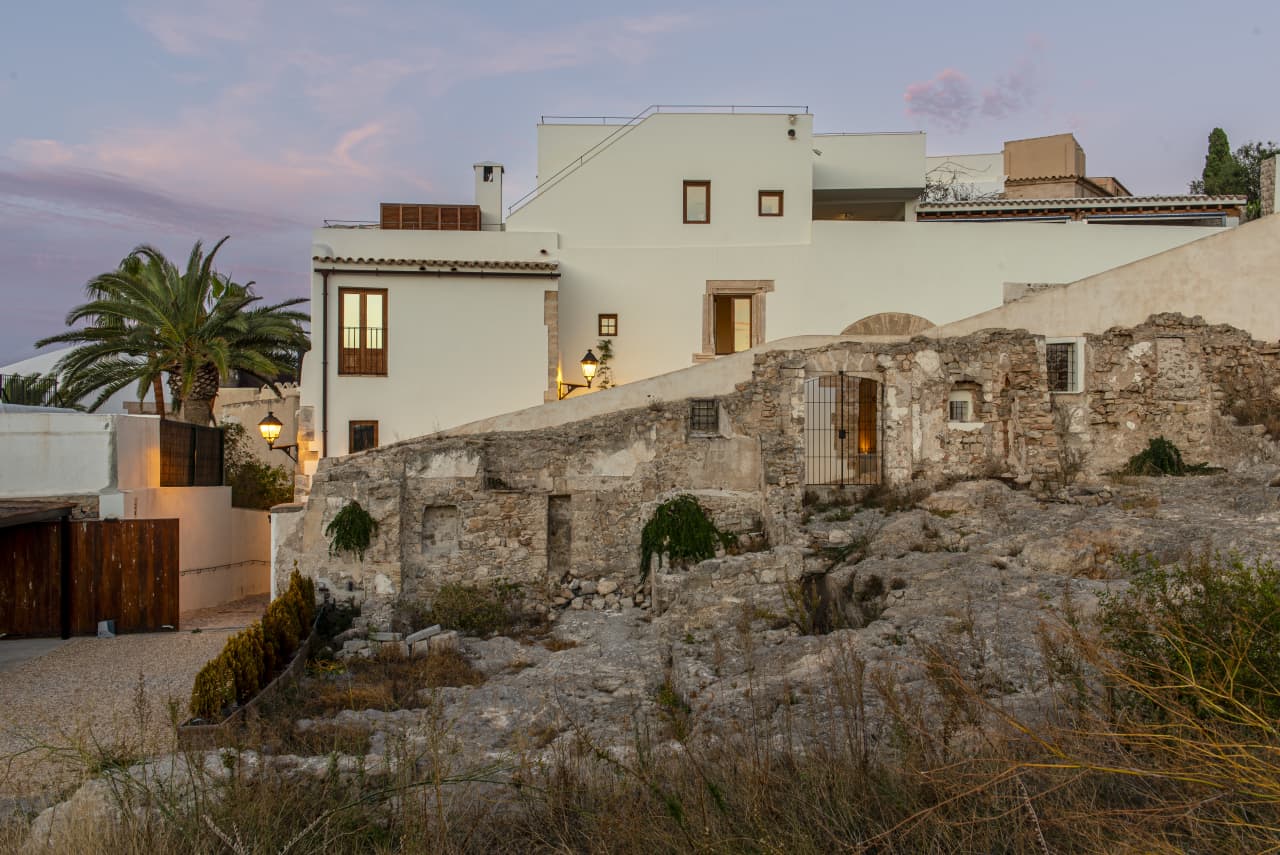There’s a New Menace Stalking Suburbia. Meet the McBasement.
Limits on above-ground mansion sizes lead to mammoth grottos with tennis courts and whiskey-tasting rooms. Beverly Hills pushes back: `Violence against the land’
When Sterling McDavid’s parents bought a roughly 9,000-square-foot home on Aspen’s Red Mountain, the 33-year-old interior designer directed the architect and contractors to start digging.
Limited by zoning above ground, Ms. McDavid, who led the renovation, envisioned an expansive basement with a world-class gym, guest suites and hotel-caliber spa for her parents, former college track star Stacie McDavid, and David McDavid, a former owner of the Dallas Mavericks and car-dealership mogul.
“I love a basement,” says Ms. McDavid, who ultimately blew out her parents’ basement to more than double its size. “When you walk into a home, if all the magic is just within the first few steps, that’s no fun.”
Wealthy Londoners have long built basements reaching two, three, and even four stories below ground. Now, there is a cellars market in the U.S. among property owners facing restrictions on mansion sizes above ground. The McBasements of today have bars, bowling alleys, pools, climbing walls and whiskey-tasting rooms. To sidestep subterranean gloom, builders usher in natural light via grand staircases or skylights cut into the ground above.
“Down is the new up,” says Randy Correll, partner at Robert A.M. Stern Architects, who designs basements with luxe finishes. “Twenty years ago, basements were the ‘B word.’”
Ms. McDavid says the excavation for her parent’s 4,000-square-foot Aspen basement added about a year to the three-year renovation, since workers dug underneath the home and into a mountainside. The resulting basement has guest suites, a gym with white oak floors, a 12-person hot tub and an “absurdly large” steam room, she says. “You feel like you’re in a luxury cave.”
She says the prior owner, by contrast, had done little to maximise the basement, which was “absolutely heinous.” (“It had wine storage, not to be confused with a wine cellar,” she says.)
Still, some towns have cracked down on the chic crypts, worried about unsettling topography and having truckloads of excavated dirt roll through residential streets. In Aspen, a resident sued the city for permitting a neighbour’s two-story basement, alleging excessive noise and dust. Aspen now limits basements to one level. And the Beverly Hills Planning Commission is now mired in a down-and-dirty basement brouhaha.
The island of Nantucket, just 14 miles long and 3.5 miles wide, limits home sizes with more than 20 zoning districts. Some areas allow a footprint covering only 2 percent of the property.
One solution? Go low. “The possibilities are endless,” says Stephen Cheney, owner of Cheney Custom Homes, who is currently constructing a roughly 16,000-square-foot home and guest home with a 5,600-square-foot “bunker” below for a bowling alley, 3-D golf simulator, and spa.
Basements can dwarf homes above. Designer Andrew Kotchen, a principal at Workshop/APD, is working on a 5,000-square-foot Nantucket abode that will have a 10,000-square-foot basement with a basketball court, garage, bedrooms and a wellness space.
In beach towns, architects are deploying extreme waterproofing measures.
For the 10,000-square-foot grotto, workers are using the same waterproofing technique as Boston’s Big Dig highway project, Mr. Kotchen says. An emergency pump system and thick concrete slab underneath will prevent the foundation from floating up should water levels rise, he says.
In Aspen, a 5,000-square-foot basement at the confluence of two rivers required “dewatering,” says Ryan Walterscheid, a partner at architecture firm Forum Phi. Workers drilled wells around the site and pumped out almost a billion gallons of water before pouring the foundation. (The water was poured back into the river.)
Architect Charles Cunniffe, who designed the McDavids’ remodel, also did a basement with a tennis court. “You can’t hit big lob shots,” he says, “but you can play a decent game of tennis.”
Interior designer Bryan Graybill says a large basement at his home in East Hampton, N.Y., was the only way to fit all the amenities he and his husband desired in their 4,100-square-foot house. For frequent hosting, their 1,800-square-foot lower level has full guest quarters, a laundry room with three sets of washers and dryers, and a catering pantry with extra stemware and service for 48. “It’s like an instant party,” he says.
Beverly Hills residents are also keeping up, and down, with the neighbours.
Architect Paul McClean crafted a house there with 7,400 square feet above ground and another 12,000 below, including a 3,000-square-foot garage. The firm also designed developer Nile Niami’s roughly 105,000-square-foot Los Angeles megamansion “The One,” where about half the home sat below grade. First listed at $500 million, the property fetched $126 million at auction this year. (A relative bargain-basement deal.)
Beverly Hills leaders passed ordinances in recent years in response to what Craig Corman, former Planning Commission chairman, called a “pernicious” trend of mammoth dwellings with wedding cake-style retaining walls and massive basements. “They can be quite offensive,” he said during a recent commission meeting. Now, property owners in the Hillside area cannot remove more than 3,000 cubic yards of earth without special permits.
This has hampered real-estate investor David Taban, who is trying to build a 23,144-square-foot house, of which 9,829 would be a basement. (He wants to dig down to appease neighbours who worried his home would hurt their views.) But getting a basement of that size required removing 5,346 cubic yards of dirt, which one city planner said would amount to 594 truckloads.
“Violence to the land,” Planning Commission Chair Myra Demeter dubbed it at an August meeting.
Asked to revise, Mr. Taban’s team is set to return to the commission Thursday. As of late September, plans called for removing just 3,276 cubic yards of soil, according to attorney Ronald Richards, a representative for Mr. Taban, who also argued the project should be permitted since the proposal predates some restrictive rules.
“It’s not even that crazy of a project in our mind,” says Russell Linch, another Taban representative.
Spec developers know the more liveable space, the bigger the price tag, says Brett Loehmann, a project manager at McClean Design. “If you don’t have great amenities, you’re not going to be the coolest person on the block.”
 Copyright 2020, Dow Jones & Company, Inc. All Rights Reserved Worldwide. LEARN MORE
Copyright 2020, Dow Jones & Company, Inc. All Rights Reserved Worldwide. LEARN MORE
This stylish family home combines a classic palette and finishes with a flexible floorplan
Just 55 minutes from Sydney, make this your creative getaway located in the majestic Hawkesbury region.
As Paris makes its final preparations for the Olympic games, its residents are busy with their own—packing their suitcases, confirming their reservations, and getting out of town.
Worried about the hordes of crowds and overall chaos the Olympics could bring, Parisians are fleeing the city in droves and inundating resort cities around the country. Hotels and holiday rentals in some of France’s most popular vacation destinations—from the French Riviera in the south to the beaches of Normandy in the north—say they are expecting massive crowds this year in advance of the Olympics. The games will run from July 26-Aug. 1.
“It’s already a major holiday season for us, and beyond that, we have the Olympics,” says Stéphane Personeni, general manager of the Lily of the Valley hotel in Saint Tropez. “People began booking early this year.”
Personeni’s hotel typically has no issues filling its rooms each summer—by May of each year, the luxury hotel typically finds itself completely booked out for the months of July and August. But this year, the 53-room hotel began filling up for summer reservations in February.
“We told our regular guests that everything—hotels, apartments, villas—are going to be hard to find this summer,” Personeni says. His neighbours around Saint Tropez say they’re similarly booked up.
As of March, the online marketplace Gens de Confiance (“Trusted People”), saw a 50% increase in reservations from Parisians seeking vacation rentals outside the capital during the Olympics.
Already, August is a popular vacation time for the French. With a minimum of five weeks of vacation mandated by law, many decide to take the entire month off, renting out villas in beachside destinations for longer periods.
But beyond the typical August travel, the Olympics are having a real impact, says Bertille Marchal, a spokesperson for Gens de Confiance.
“We’ve seen nearly three times more reservations for the dates of the Olympics than the following two weeks,” Marchal says. “The increase is definitely linked to the Olympic Games.”

Getty Images
According to the site, the most sought-out vacation destinations are Morbihan and Loire-Atlantique, a seaside region in the northwest; le Var, a coastal area within the southeast of France along the Côte d’Azur; and the island of Corsica in the Mediterranean.
Meanwhile, the Olympics haven’t necessarily been a boon to foreign tourism in the country. Many tourists who might have otherwise come to France are avoiding it this year in favour of other European capitals. In Paris, demand for stays at high-end hotels has collapsed, with bookings down 50% in July compared to last year, according to UMIH Prestige, which represents hotels charging at least €800 ($865) a night for rooms.
Earlier this year, high-end restaurants and concierges said the Olympics might even be an opportunity to score a hard-get-seat at the city’s fine dining.
In the Occitanie region in southwest France, the overall number of reservations this summer hasn’t changed much from last year, says Vincent Gare, president of the regional tourism committee there.
“But looking further at the numbers, we do see an increase in the clientele coming from the Paris region,” Gare told Le Figaro, noting that the increase in reservations has fallen directly on the dates of the Olympic games.
Michel Barré, a retiree living in Paris’s Le Marais neighbourhood, is one of those opting for the beach rather than the opening ceremony. In January, he booked a stay in Normandy for two weeks.
“Even though it’s a major European capital, Paris is still a small city—it’s a massive effort to host all of these events,” Barré says. “The Olympics are going to be a mess.”
More than anything, he just wants some calm after an event-filled summer in Paris, which just before the Olympics experienced the drama of a snap election called by Macron.
“It’s been a hectic summer here,” he says.

AFP via Getty Images
Parisians—Barré included—feel that the city, by over-catering to its tourists, is driving out many residents.
Parts of the Seine—usually one of the most popular summertime hangout spots —have been closed off for weeks as the city installs bleachers and Olympics signage. In certain neighbourhoods, residents will need to scan a QR code with police to access their own apartments. And from the Olympics to Sept. 8, Paris is nearly doubling the price of transit tickets from €2.15 to €4 per ride.
The city’s clear willingness to capitalise on its tourists has motivated some residents to do the same. In March, the number of active Airbnb listings in Paris reached an all-time high as hosts rushed to list their apartments. Listings grew 40% from the same time last year, according to the company.
With their regular clients taking off, Parisian restaurants and merchants are complaining that business is down.
“Are there any Parisians left in Paris?” Alaine Fontaine, president of the restaurant industry association, told the radio station Franceinfo on Sunday. “For the last three weeks, there haven’t been any here.”
Still, for all the talk of those leaving, there are plenty who have decided to stick around.
Jay Swanson, an American expat and YouTuber, can’t imagine leaving during the Olympics—he secured his tickets to see ping pong and volleyball last year. He’s also less concerned about the crowds and road closures than others, having just put together a series of videos explaining how to navigate Paris during the games.
“It’s been 100 years since the Games came to Paris; when else will we get a chance to host the world like this?” Swanson says. “So many Parisians are leaving and tourism is down, so not only will it be quiet but the only people left will be here for a party.”
This stylish family home combines a classic palette and finishes with a flexible floorplan
Just 55 minutes from Sydney, make this your creative getaway located in the majestic Hawkesbury region.






















